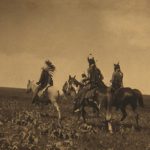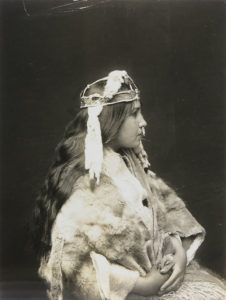 Edward S. Curtis
Edward S. Curtis
Edward Sheriff Curtis, born in 1868, dedicated his life’s work to capturing the different cultures and traditions of over 80 tribes of Indigenous peoples throughout the United States. At great cost to his personal health, family life and finances, Curtis spent decades on the road traveling in covered wagons taking thousands of photographs and documenting his ethnographic findings.
As a teenager, Curtis became interested in photography after his family moved to St. Paul, Minnesota. He began learning how to build his own camera and process prints while working as an apprentice in a photography studio, until his family relocated to Seattle, Washington. Once settled in Seattle, he married and bought a share in a photography studio.
In 1899, Curtis left his flourishing studio and his young family to work as the official photographer for the Harriman Alaska Expedition where he accompanied many prominent scientists of the time, including naturalist John Muir and archaeologist George Bird Grinnell. Curtis was also invited a year later by Bird Grinnell to go with him to Montana where he photographed the Piegan people and became captivated by the customs and traditions of Native Americans. After this, Curtis began to travel more extensively to photograph Native Americans throughout the United States.
Once Curtis returned to Seattle, he published his photographs and began lecturing on them around the country. He gained notoriety and captured the attention of Theodore Roosevelt who hired him to photograph his family portraits and daughter’s wedding. In 1906, Curtis garnered the attention of another powerful man, J.P. Morgan, who offered to sponsor his work. Using this money, he was able to hire translators, researchers, and fund his travels throughout America.
The culmination of the Curtis’ efforts, The North American Indian Project, is a 20 volume body of work that features photographs and ethnographic information that was recorded from 1900-1930. Curtis took over 40,000 photographs of more than 80 tribes of Native American Indians with the goal of depicting the traditional life of his subjects. In addition to the photographs, he also gained permission to make over 10,000 wax cylinder recordings of Native American language and music.
In the Land of the Head Hunters
J.P. Morgan’s unexpected death in 1913 affected Curtis’ financial situation immensely. In an attempt to alleviate some of the financial struggles caused by losing Morgan’s subsidies, Curtis decided to invest the rest of his funding into a motion picture: In the Land of the Head-Hunters (1914). He hoped that the film would be a commercial success and that he would be able to use the profits to fund his other projects. The silent film, categorized as a docu-drama, was written and directed by Curtis. He enlisted the Kwakiutl people of Vancouver Island, British Columbia as actors in the film. The film was a commercial failure, but it attracted some praise for its depictions of Kwakiutl life during that era.
During the July 2018 sale, Clars Auction Gallery will be auctioning off a collection of seven gelatin silver prints of the Kwakiutl people taken during the 1914 filming of In the Land of the Head-Hunters. The collection features a portrait of Naida, one of the main characters in the movie. In the portrait, the actress playing Naida can be seen adorned with furs, a grass skirt, a woven headdress and a nose ring. Curtis directed the actors to dress as their forefathers did, by wearing traditional clothes and fake nose rings and wigs.
Curtis’ depictions of Native American peoples have been received with mixed reviews. Many value Curtis’ photos for their documentation of Native American traditional life. These photographs have been used as a reference for reconstructing cultural practices and recording traditions that augment oral history. However, Curtis’ work ignores the harsh realities of Native American life during the early 1900s, and his photographs are often staged, showing Native Americans posed in traditional dress. Often, the images were retouched to eliminate evidence of modern life.

A photograph of Nadia, along with other photographs by Curtis, is on display currently at the Seattle Art Museum as part of their Double Exposure: Edward Curtis, Marianne Nicolson, Tracy Rector, and Will Wilson exhibit that features 150 images by Curtis juxtaposed by the work of three contemporary, Indigenous artists.
You can view the entire film on YouTube and there is a great panel discussion hosted by SFU including Andy Everson who is the grandson of one of the film’s stars, Margaret Frank, who played the role of Princess Naida.



